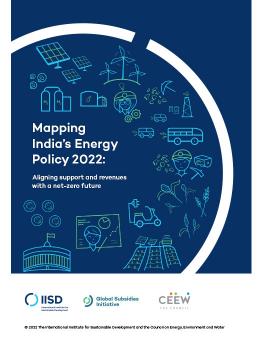May 31, 2022, New Delhi—Renewable energy subsidies in India have fallen by 59% to INR 6,767 crore after peaking at INR 16,312 crore in FY 2017 as deployment slowed during COVID-19 pandemic-induced lockdowns and grid-scale solar photovoltaic and wind achieved cost parity, according to a joint independent study released today by the Council on Energy, Environment and Water (CEEW) and the International Institute for Sustainable Development (IISD). To achieve the 2030 clean energy targets, more support—which may include subsidies—will be needed to scale up solar manufacturing, green hydrogen, and promising decentralized renewable energy technologies.
The report, titled Mapping India’s Energy Policy 2022: Aligning Support and Revenues with a Net-Zero Future, found that overall, India’s subsidies for fossil fuels, such as coal, oil, and gas, dropped notably by 72% to INR 68,226 crore during the 7 years between 2014 and 2021. However, fossil fuel subsidies in FY 2021 are still nine times higher than renewable energy subsidies. The country, therefore, needs to shift support away from fossil fuels and toward clean energy technologies to reach 500 GW of non-fossil power capacity by 2030 and net-zero emissions by 2070.
Overall, India provided over INR 540,000 crore to support the energy sector in FY 2021, including nearly INR 218,000 crore in the form of subsidies. Most notably, in May 2022, India reintroduced liquefied petroleum gas (LPG) subsidies for the beneficiaries of the Pradhan Mantri Ujjwala Yojna (PMUY) scheme in an attempt to target the subsidies to low-income consumers.
“The centre and the states must ensure adequate support and financing models for clean energy in the medium and long term, in line with India’s stated decarbonization goals. Our policy-makers should also find ways to offer affordable clean cooking energy to the poor and vulnerable sections. Targeted LPG subsidy in the short term is the only solution to ensure that the program goals of PMUY—which help pay the cost of using LPG for the first time—are not left by the wayside,” said co-author of the study Karthik Ganesan, Fellow and Director of Research Coordination at CEEW.
The study further notes that electric vehicle (EV) subsidies have more than tripled since FY 2017 to INR 849 crore in FY 2021. During the year, India announced a production-linked incentive program to attract investments in domestic manufacturing of EVs and components. With manufacturing receiving a boost, clean energy financing will be the next step to further scale up deployment.
The report highlights that India’s non-banking financial companies are now playing a major role in shifting public finance away from fossil fuels, but as of today, no public finance institutions (PFIs) have established clear plans for phasing out finance for fossil fuels. In fact, annual disbursements by the largest PFIs were three times higher for fossil generation than renewable energy in FY 2021, according to the report. While several public sector undertakings (PSUs) announced new clean energy partnerships and targets, they need to set out clear strategies for adjusting business models to clean energy transition and net-zero, experts recommend.
“To accelerate the pace of India’s energy transition, public finance institutions need to increase the clean energy sector lending targets, in line with stated policy targets, and develop a medium- to long-term roadmap for phasing out public finance for fossil fuels and managing possible stranded assets,” said co-author of the report Swasti Raizada, Policy Advisor at IISD. “They should seek to swiftly end new public finance for coal-based power plants or mining to minimize the already high levels of exposure to fossil assets.”
Media Contacts:
Riddhima Sethi (CEEW) – riddhima.sethi@ceew.in; +91 99020 39054
Swasti Raizada (IISD) – sraizada@iisd.org
About CEEW
The Council on Energy, Environment and Water (CEEW) is one of Asia’s leading not-for-profit policy research institutions. The Council uses data, integrated analysis, and strategic outreach to explain—and change—the use, reuse, and misuse of resources. It prides itself on the independence of its high-quality research, develops partnerships with public and private institutions, and engages with the wider public. In 2021, CEEW once again featured extensively across 10 categories in the 2020 Global Go To Think Tank Index Report. The Council has also been consistently ranked among the world’s top climate change think tanks. Follow us on Twitter @CEEWIndia for the latest updates.
